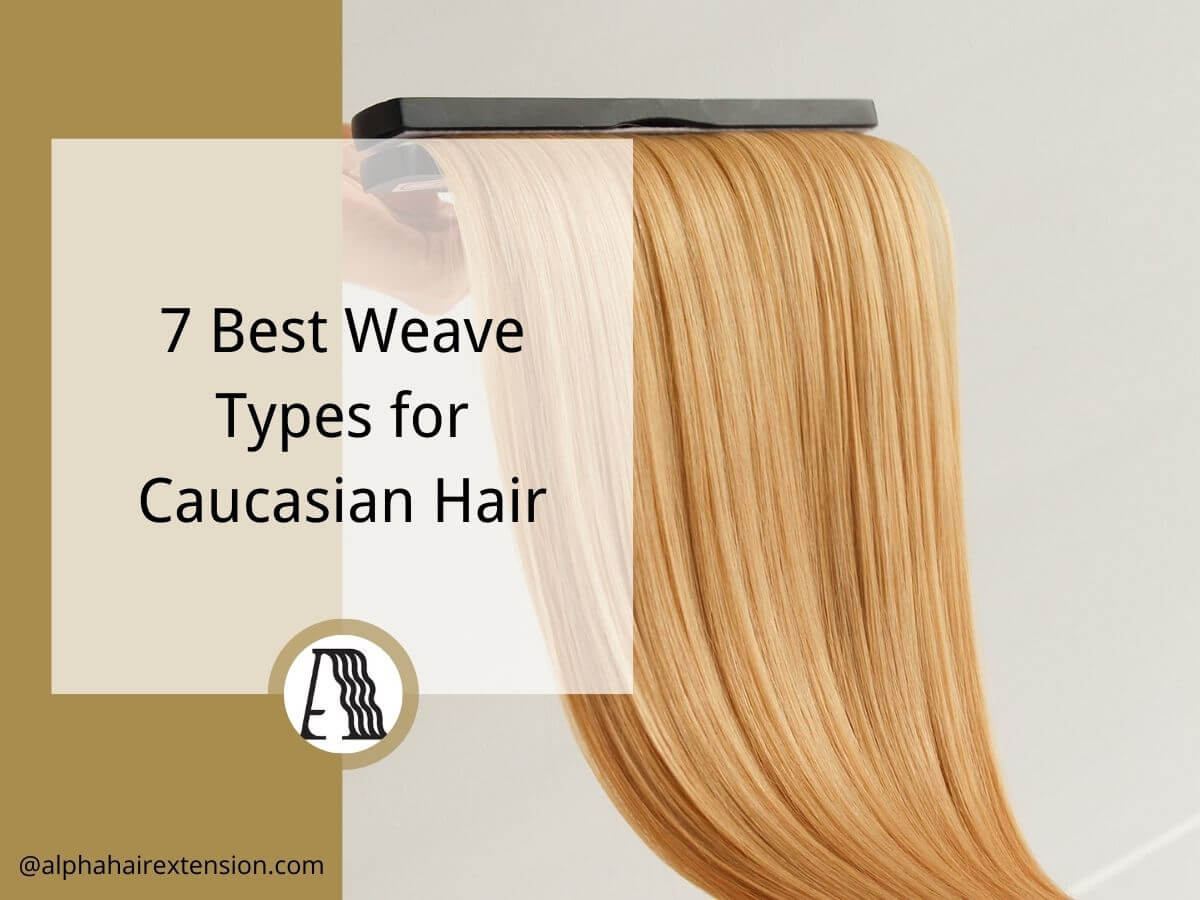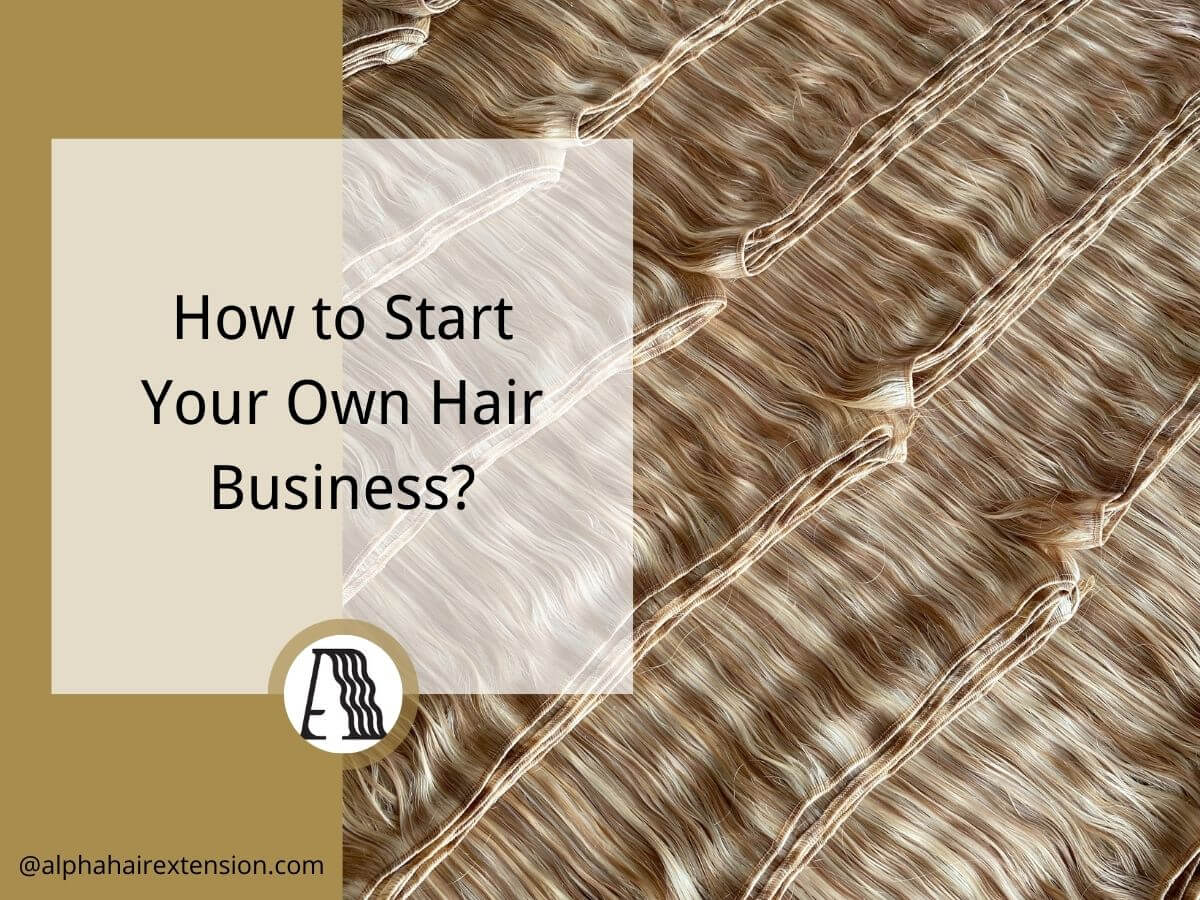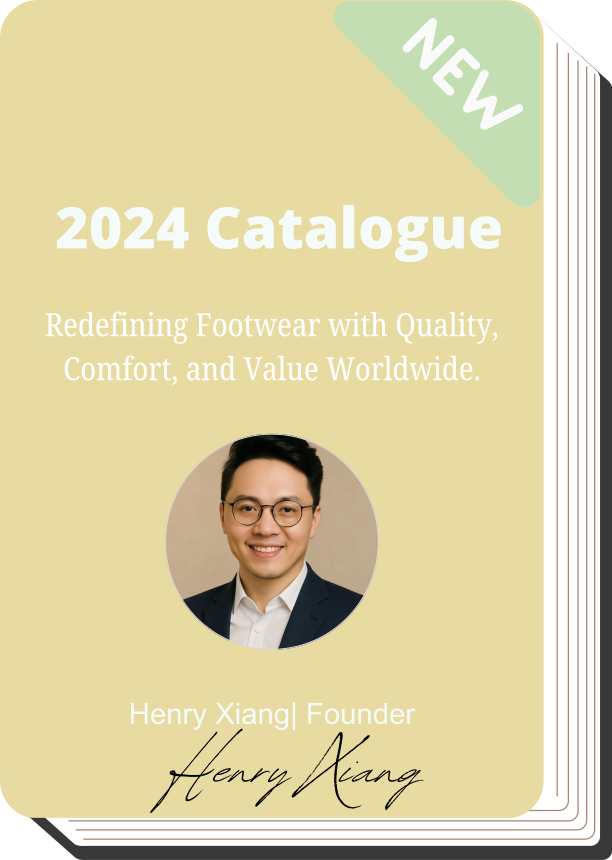When I first started working with hair extensions, I made a mistake. I trusted a supplier without understanding how the product was made.
The result?
Inconsistent quality, unhappy customers, and wasted money. I learned my lesson the hard way.
If you’re a brand owner, salon professional, or e-commerce seller, you don’t have to make the same mistake. Knowing how hair extensions are made—from raw hair collection to the final product—helps you avoid unreliable suppliers.
This guide walks you through every step—from raw materials to the final product. You’ll learn what to look for in a manufacturer, how to evaluate quality, and why production methods matter.
The more you know, the better choices you can make.
So let’s get started!
1. Hair Sourcing
Hair extensions start with sourcing the right materials. Manufacturers use either natural human hair or synthetic fibers to create extensions. The quality of the hair at this stage affects how the final product looks, feels, and lasts.
Human Hair
Human hair is the preferred choice for high-end extensions. It comes from different sources:
- Donors: Individuals sell or donate their hair, often in exchange for payment.
- Temples: In countries like India, people offer their hair as part of religious traditions. This hair is later collected and sold.
- Salons: Some manufacturers gather hair that has been cut during salon visits, though this method is less common.
The highest-quality human hair is Remy hair. This means the cuticles remain intact and aligned in the same direction. Because of this, Remy hair is smooth, tangle-free, and long-lasting. Non-Remy hair, on the other hand, often goes through harsh processing to reduce tangling, which affects its durability.
Synthetic Hair
Some extensions are made from synthetic fibers, not human hair. These fibers are usually fine plastics, such as acrylic or polyester, treated to look like real hair.
Synthetic hair has benefits:
- Lower cost: It’s more affordable than human hair.
- Consistent texture: Every strand looks the same, with no natural variation.
But there are downsides. Synthetic hair doesn’t last as long, can’t be heat-styled like human hair, and may not feel as natural.
When choosing a supplier, you need to know what type of hair they use. The sourcing method impacts quality, price, and overall customer satisfaction.
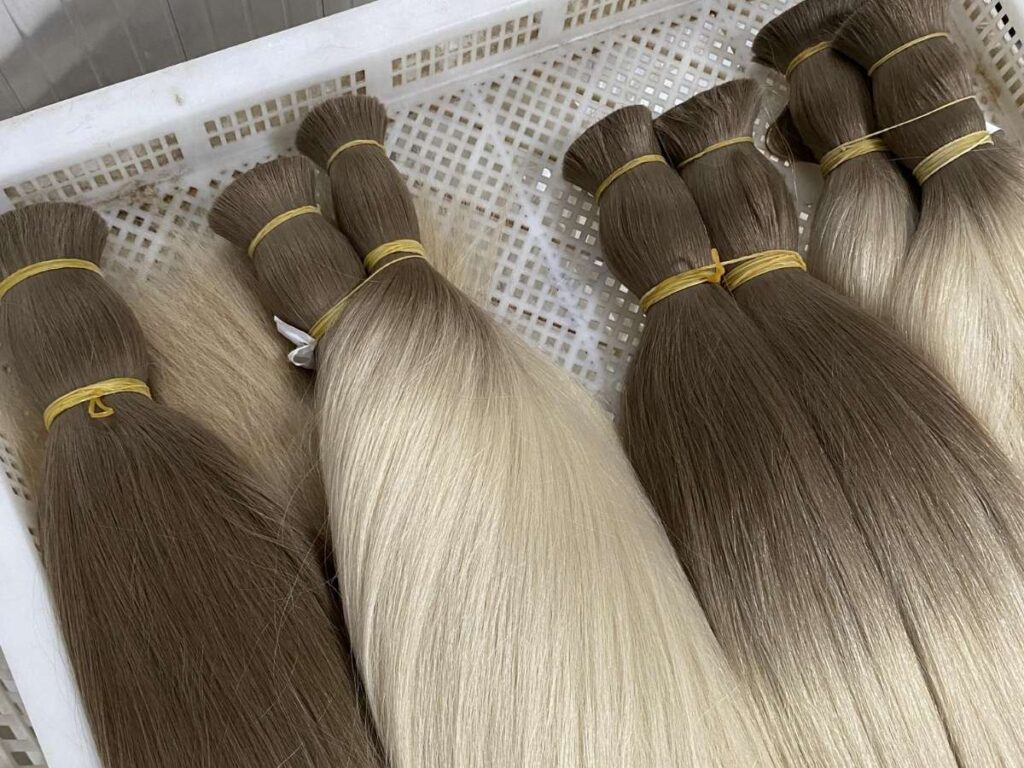
2. Sorting & Cleaning
Once the hair is collected, it goes through sorting and cleaning. This step is crucial. It determines the final texture, appearance, and overall quality of the extensions.
Sorting the Hair
Hair does not arrive in perfect bundles. It needs to be sorted based on several factors:
- Length: Longer strands are more valuable. Workers carefully separate hair into uniform lengths.
- Texture: Some hair is naturally straight, while others have waves or curls. Sorting by texture ensures consistency.
- Quality: Remy hair, where cuticles remain intact, is kept separate from non-Remy hair.
Keeping Remy hair separate is important. If mixed with non-Remy strands, the quality drops. Cuticles in different directions cause tangling and rough textures.
Cleaning the Hair
Raw hair is not ready for use yet. It carries dust, oils, and other impurities. To prepare it, manufacturers wash the hair using a mild cleansing solution. This process:
- Removes dirt and product buildup
- Gets rid of bacteria and potential contaminants
- Leaves hair fresh, soft, and clean
The cleaning method matters. Harsh chemicals can weaken the hair, making it brittle. High-end manufacturers use gentle, sulfate-free shampoos to protect the strands.
After washing, the hair dries naturally or under controlled conditions. At this stage, the extensions are clean, soft, and ready for further processing.
Sorting and cleaning may seem basic, but they affect everything—from how the hair moves to how long it lasts. If a supplier rushes this step, the final product suffers.
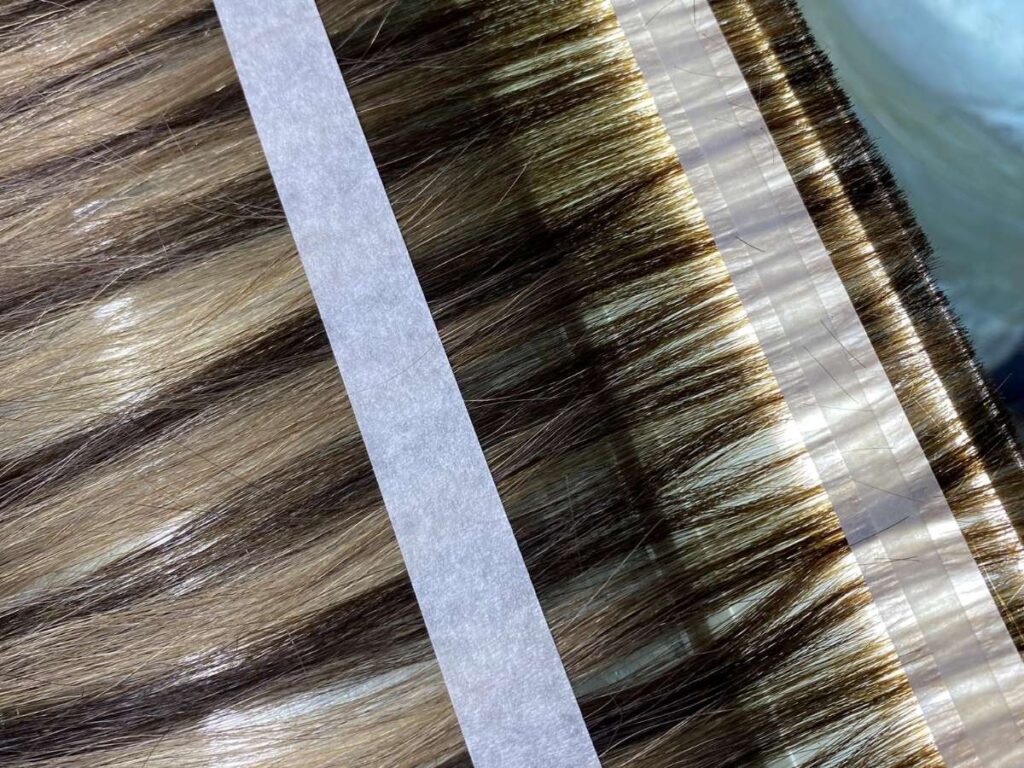
3. Wefting or Bonding
Once the hair is clean and sorted, it’s time to turn it into extensions. The method depends on the type of extension being made. Some are sewn onto fabric strips, while others are bonded with adhesives or keratin.
Weft Hair Extensions
Weft extensions are made by sewing hair onto a fabric or lace strip called a weft. This can be done in two ways:
- Machine-sewn wefts: Faster to produce and more durable, but can be thicker.
- Hand-tied wefts: Thinner and more flexible, making them a better option for fine hair.
Weft extensions are popular for sew-in installations and wigs. They offer long wear and can be customized.
Tape-In Extensions
Tape-in extensions have adhesive strips at the base. These strips allow for quick installation. The process involves sandwiching a section of natural hair between two tape-in extensions.
- Fast to apply: A full head takes under an hour.
- Flat and lightweight: Blends easily for a natural look.
Tape-ins work well for clients who want semi-permanent extensions without sewing or bonding.
Keratin Bond Extensions
Keratin bond extensions use tiny keratin tips that attach to natural hair with heat.
- Long-lasting: Can stay in for up to 4 months.
- Strand-by-strand application: Provides natural movement.
These are ideal for clients who want a discreet, permanent solution. However, they require professional application and maintenance.
Clip-In Extensions
Clip-in extensions are for temporary use. They consist of hair sewn onto fabric strips with small clips attached.
- Easy to install and remove: No salon visit required.
- Great for occasional wear: Perfect for events or special occasions.
If you’re choosing a supplier, it’s important to check how the extensions are made. A strong weft, secure adhesive, or durable keratin tip can make all the difference in product quality.
4. Coloring & Processing
Once the hair is attached to a weft or bonded for extensions, it moves to the coloring and processing stage. This step ensures the hair matches different shades and textures, giving customers more options.
Coloring Human Hair
Most raw hair doesn’t arrive in a uniform color. It needs to be dyed to match industry shade charts. The process varies:
- Bleaching: Lightens dark hair to create blonde shades.
- Toning: Removes unwanted tones, like brassiness in blonde hair.
- Dyeing: Deposits color to match natural and fashion shades.
- Highlighting: Add dimension with lighter strands.
High-quality manufacturers use gentle dyes to protect the hair. Too much chemical processing can weaken strands, leading to dryness and breakage.
Coloring Synthetic Hair
Synthetic extensions are different. They’re pre-colored during production using pigments blended into the plastic fibers. Because of this, synthetic hair cannot be dyed later like human hair.
Texturizing for Waves and Curls
Not all hair comes in the perfect curl or wave pattern. Many extensions go through a texturizing process to create specific styles.
- Steam processing: A chemical-free method using heat to set curls or waves.
- Chemical perming: Used for stronger curl patterns but can weaken hair over time.
If you’re selecting a supplier, ask about their coloring and processing techniques. Harsh treatments can shorten the lifespan of extensions, affecting their quality and customer satisfaction.
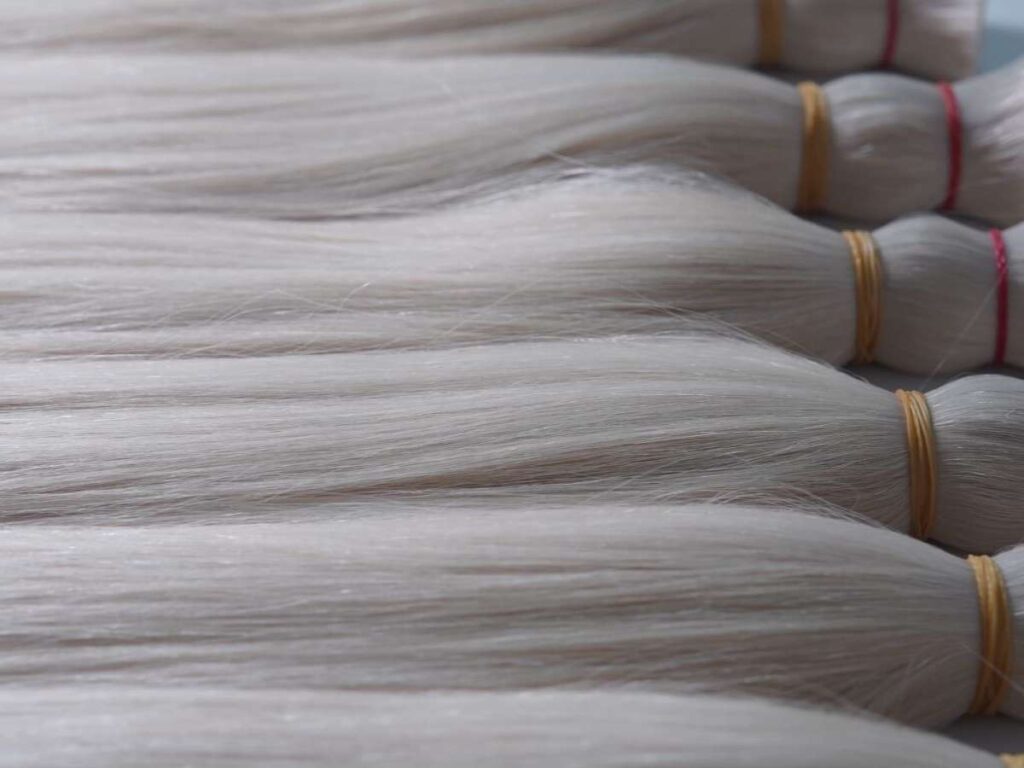
5. Conditioning & Quality Control
Hair extensions go through a final round of conditioning and quality checks before reaching the market. This step determines how soft, strong, and long-lasting the product will be.
Deep Conditioning for Softness
After coloring and processing, hair can lose moisture. To restore its softness and shine, manufacturers apply deep conditioning treatments.
- Hydrating masks: Replenish lost moisture.
- Silicone coatings: Add smoothness and shine (though overuse can create buildup).
- Protein treatments: Strengthen strands and reduce breakage.
Well-conditioned hair moves naturally and feels soft. Poorly treated hair feels dry, rough, and lifeless.
Quality Control Checks
How do you know if an extension is high quality? Good manufacturers test every batch to meet industry standards.
- Thickness check: Hair should be even from top to tip. Thin, scraggly ends signal poor quality.
- Strength test: Strands are gently pulled to check durability. Weak hair breaks easily.
- Uniformity check: Color, length, and texture must be consistent across each bundle.
Shedding, Tangling & Durability Tests
Before packaging, extensions go through final tests:
- Shedding test: Light brushing should not cause excessive hair loss.
- Tangling tes: Hair is combed multiple times to check smoothness.
- Durability test: Some manufacturers wash and style test samples to see how they hold up over time.
If a supplier skips these steps, you might end up with low-quality extensions that don’t last. Always ask about quality control when choosing a manufacturer. Would you trust a product that hasn’t been tested?
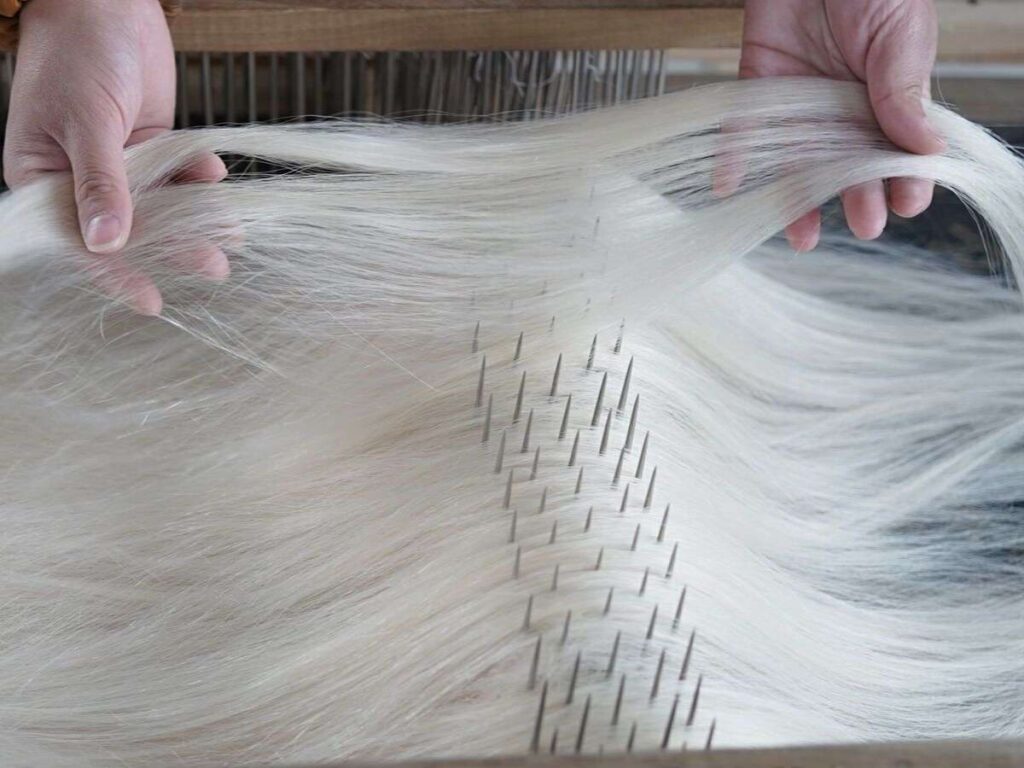
6. Cutting & Styling
Once the extensions pass quality checks, they move to the final stage—cutting and styling. This step shapes the hair, evens out the length, and adds the finishing touches before packaging.
Trimming for Even Length
Raw hair bundles don’t always have perfect ends. Some strands are longer than others. To fix this, manufacturers trim the extensions to create a clean, even look.
- Machine-trimmed: Ensures uniform length across all bundles.
- Hand-cut: Allows for more natural movement and layering.
Uneven ends can make extensions look cheap. A precise cut improves the final look and helps with styling.
Pre-Styled Options
Not all extensions come straight. Some are pre-styled to match different customer needs.
- Straight: Sleek and smooth for a polished look.
- Wavy: Soft waves for a natural, effortless style.
- Curly: Tight or loose curls, depending on the desired effect.
These textures are created using steam processing or chemical treatments. High-quality manufacturers use heat and moisture instead of harsh chemicals to protect the hair’s integrity.
Hand-Cut for Natural Layering
Some premium extensions go through hand-cut layering. This method creates:
- Seamless blending: Works well for natural looks.
- Face-framing styles: Enhances volume and shape.
- Soft movement: Prevents a bulky, blocky appearance.
When choosing a supplier, ask about their cutting and styling methods. Proper finishing can make extensions look more natural and appealing to your customers.
7. Packaging & Distribution
The final step in making hair extensions is packaging and distribution. Proper packaging keeps the extensions protected, tangle-free, and ready for sale.
Careful Packaging to Prevent Damage
Hair extensions are delicate. Poor packaging can lead to tangling, shedding, or frizz before the product even reaches the customer. To prevent this, manufacturers use:
- Silk or plastic sleeves: Keeps hair smooth and untangled.
- Hairnets: Holds the extensions in place.
- Secure bands or ties: Prevents shifting during shipping.
Some brands also add moisture-resistant packaging to keep the hair in top condition.
Branding & Labels
Before shipping, manufacturers customize the packaging to fit the brand’s identity. This includes:
- Logos and brand colors: Helps customers recognize your product.
- Hair type and shade labels: Makes it easy to identify different options.
- Care instructions: Guides users on how to maintain the extensions.
For private-label brands, suppliers offer customized packaging to match the company’s image.
Shipping & Distribution
Once packaged, hair extensions are ready for distribution. They are shipped to:
- Salons: For professional use and retail sales.
- Beauty supply stores: Stocked on shelves for walk-in customers.
- Online retailers: Sold directly through e-commerce platforms.
Reliable suppliers use fast, secure shipping to ensure products arrive in perfect condition. A delayed or damaged shipment can hurt your business. That’s why choosing a supplier with a strong logistics network is important.
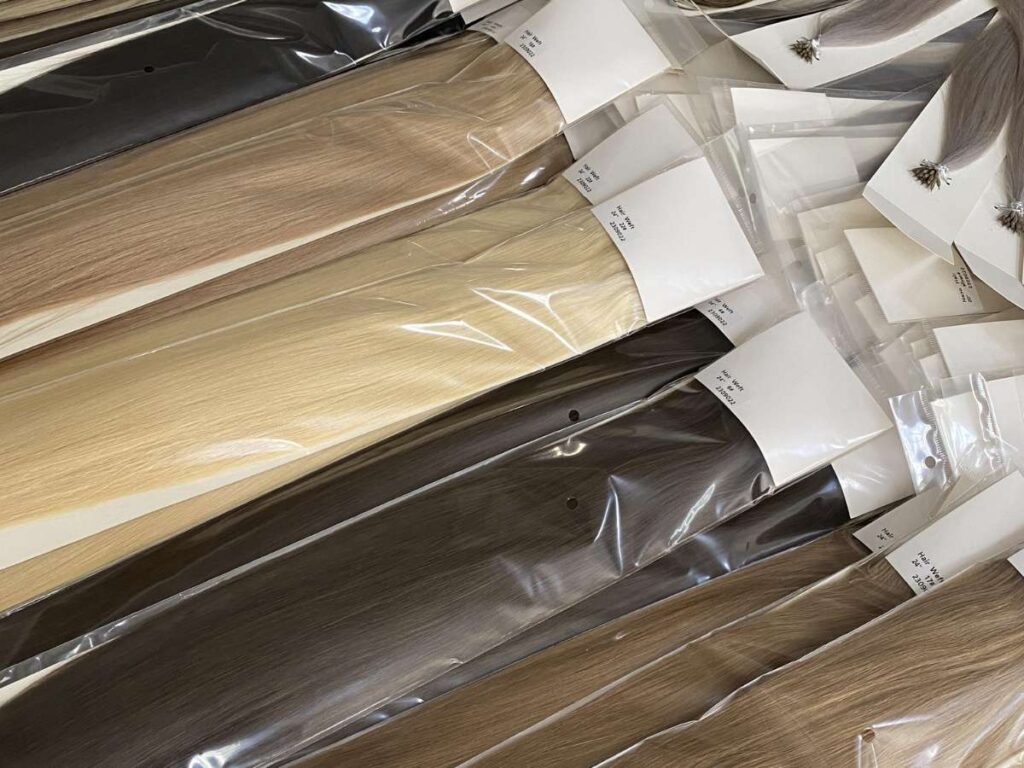
Conclusion
Hair extensions go through a long journey before reaching your hands. From sourcing and sorting to bonding, coloring, and packaging, every step affects quality.
I remember standing in that factory, running my fingers through freshly finished bundles. The difference between well-made extensions and cheap ones was clear.
Now, you know what to look for too.
If you’re serious about offering high-quality extensions, don’t just trust a supplier’s word—evaluate their process.
Are you ready to take that step?
Let’s connect and find the best hair solutions for your business. Contact us today!
Explore More Helpful Resources
There’s more to explore! Check out our additional product selections to find exactly what you’re looking for:
If you’re looking for more insights, we’ve put together a list of helpful articles that you might enjoy:
Still haven’t found what you’re looking for? Don’t hesitate to contact us. We’re available around the clock to assist you.


